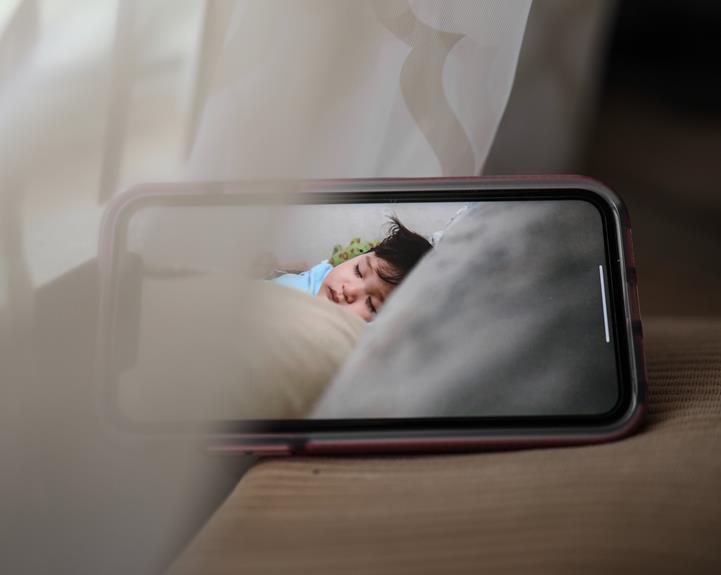Do Movement Monitors Help Prevent SIDS?
SIDS, or Sudden Infant Death Syndrome, is potentially one of a new mother and father’s greatest fears. It is a gut-wrenching terror that you will leave your child to sleep soundly only to return to a lifeless body. All the causes of Sudden Infant Death Syndrome (SIDS) are still unclear, but doctors have identified that SIDS can occur when an infant rolls onto their stomach restricting airflow to their mouth and nose.
You may wonder why a child rolling over to their stomach is a cause of SIDS. This is due to a child of this age not having the muscle tone and strength to return to laying on their back. They are unable to lay on their side when sleeping and can easily smother themselves if falling into an incorrect position. This is why many parents will only place the child’s crib in their bedrooms when he/she can control their body movements.
While many parents choose to ‘keep an eye’ on their child, there are certain positions doctors have advised to reduce SIDS occurring. It is highly recommended that parents place their infant on his/her back to sleep. It is also recommended that the child sleep on a hard surface instead of a soft one. Yet, irrespective of the correct positions and softness of a bed, one may still be concerned with the issue of sleeping and smothering. Certain devices are used to help reduce infant deaths in this case.
Although parents will use different types of products such as specific mattresses, the more popular ‘parenting aids’ are monitors. Baby monitors are often used to detect an infant’s breathing, and any disruption in the pattern can alert a parent to possible difficulties. However, these breathing monitors have not been noted as the most effective safeguard for SIDS. One option beyond the breathing monitor is the movement monitor.
Do movement monitors help prevent SIDS?
Movement monitors do not help prevent SIDS.
In fact, they do not guarantee infant safety or reduce the risk of SIDS in healthy infants.
These monitors may actually increase parental anxiety, stress, and disrupt sleep.
Additionally, they can be prone to false alarms and inaccuracies in measurements.
The FDA does not regulate or approve SIDS baby monitors, and popular monitors have shown inconsistencies in accuracy compared to hospital-grade equipment.
Safe sleeping guidelines, such as the Back to Sleep campaign, and practicing safe sleep habits recommended by experts like Dr.
Manrique, are more effective in preventing SIDS than relying on movement monitors.
Key Points:
- Movement monitors do not prevent SIDS and do not ensure infant safety or reduce the risk of SIDS in healthy infants.
- They may increase parental anxiety, stress, and disrupt sleep.
- Movement monitors can be prone to false alarms and inaccuracies in measurements.
- The FDA does not regulate or approve SIDS baby monitors, and popular monitors have shown inconsistencies compared to hospital-grade equipment.
- Safe sleeping guidelines like the Back to Sleep campaign and following expert recommendations are more effective in preventing SIDS than relying on movement monitors.
Check this out:
💡 Did You Know?
1. Swaddling babies has been shown to reduce the risk of SIDS, as it can prevent the startle reflex from waking the baby during sleep.
2. Breastfeeding has been associated with a decreased risk of SIDS, as breast milk provides important antibodies and nutrients that help boost a baby’s immune system.
3. Keeping the baby’s sleep environment free from loose bedding, soft toys, and pillows can reduce the risk of SIDS, as these items can pose suffocation hazards.
4. Babies who are exposed to cigarette smoke, either during pregnancy or after birth, are at a higher risk of SIDS due to the harmful chemicals and toxins in the smoke.
5. Using a pacifier during naps and bedtime has been linked to a decreased risk of SIDS, as it may help keep the airway open and prevent the baby from going into a deep sleep.
Limited Efficacy
- Movement monitors, while marketed as tools to help prevent Sudden Infant Death Syndrome (SIDS), do not guarantee infant safety or prevent SIDS.
- These monitors are designed to track a baby’s movements, heart rate, and oxygen levels, but their efficacy in preventing SIDS is limited.
- There is no concrete evidence to suggest that these monitors reduce the risk of SIDS in healthy infants.
- A study conducted in 2018 revealed inconsistencies in the accuracy of heart rate and oxygen blood level measurements by popular baby monitors when compared to hospital-grade monitors.
Parental Stress
- Movement monitors have been intended to provide reassurance to parents.
- However, they can paradoxically lead to increased anxiety, stress, and sleep disruption.
- The constant monitoring and potential for false alarms can elevate parental anxiety levels.
- This can result in sleep disturbances and overall stress for parents.
- The false sense of security offered by these monitors may create a false sense of urgency and panic.
- Such reactions may not necessarily help prevent SIDS.
Potential Misuse
- Misuse of movement monitors can lead to inaccurate readings and missing genuine distress signs in infants.
- Improper monitor placement or misinterpretation of data may cause false alarms or overlook warning signs.
- This misuse contributes to the inefficacy of devices in preventing SIDS.
Accuracy Concerns
- The accuracy of movement monitors in detecting vital signs has been called into question, as demonstrated by the 2018 study mentioned earlier.
- The study highlighted significant discrepancies between the readings provided by popular baby monitors and those obtained from hospital-grade monitors.
- Such inaccuracies raise concerns about the reliability of these devices in detecting potential health issues in infants and preventing SIDS.
- As a result, parents may place undue reliance on these monitors, potentially leading to a false sense of security.
Lack Of Clear Benefits
Despite extensive marketing and promotion of movement monitors as essential tools for detecting and preventing SIDS, there is a lack of clear evidence supporting their benefits. The U.S. Food and Drug Administration (FDA) does not regulate or approve SIDS baby monitors, indicating a lack of oversight in this market. Additionally, the absence of conclusive data on the effectiveness of these monitors in reducing SIDS cases further questions their utility and raises doubts about their true impact on infant safety.
Key Points:
- Lack of clear evidence supporting benefits of SIDS baby monitors
- FDA does not regulate or approve SIDS baby monitors
- Absence of conclusive data on effectiveness raises doubts about their impact
Edited Text:
Despite extensive marketing and promotion of movement monitors as essential tools for detecting and preventing SIDS, there is a lack of clear evidence supporting their benefits. The U.S. Food and Drug Administration (FDA) does not regulate or approve SIDS baby monitors, indicating a lack of oversight in this market. Additionally, the absence of conclusive data on the effectiveness of these monitors in reducing SIDS cases further questions their utility and raises doubts about their true impact on infant safety.
Key Points:
- Lack of clear evidence supporting benefits of SIDS baby monitors
- FDA does not regulate or approve SIDS baby monitors
- Absence of conclusive data on effectiveness raises doubts about their impact
Unregulated Market
- The unregulated nature of the market for SIDS baby monitors raises significant concerns about the safety and efficacy of these devices.
- Without proper oversight and regulation, manufacturers may make unsubstantiated claims about the abilities of their products, potentially misleading consumers.
- The lack of standardized testing and quality control measures can result in the proliferation of monitors that may not offer the level of protection parents expect, further complicating the issue of infant safety.
Product Withdrawal
An example of the uncertainties surrounding the use of SIDS baby monitors is the case of the Owlet Sock, a popular at-home monitor that was pulled from the market in October 2021. The reasons for its removal were not explicitly stated, but the incident underscored the challenges associated with ensuring the reliability and safety of such devices. The withdrawal of a prominent monitor like the Owlet Sock serves as a reminder of the potential risks associated with relying on unregulated products for infant care.
The case of the Owlet Sock highlights the importance of ensuring the reliability and safety of baby monitors through proper regulation.
- Uncertainties surrounding SIDS baby monitors
- Owlet Sock pulled from the market in October 2021
- Challenges in ensuring reliability and safety
- Potential risks of unregulated products for infant care
Importance Of Safe Sleeping Practices
- Amidst the debate surrounding the efficacy of movement monitors in preventing SIDS, it is crucial to emphasize the importance of adhering to safe sleeping practices recommended by organizations like the American Academy of Pediatrics (AAP).
- Safe sleep guidelines, such as the Back to Sleep campaign, have contributed to a significant decline in SIDS cases since the 1990s.
- Dr. Manrique, a renowned expert in infant safety, recommends practices such as
- placing infants on their back to sleep,
- using firm sleep surfaces,
- avoiding co-sleeping,
- dressing infants in thin clothing,
- prohibiting exposure to smoke, drugs, and alcohol,
- offering a pacifier, and
- ensuring proper air circulation with a fan.
- These evidence-based practices have proven to be effective in reducing the risk of SIDS and promoting infant safety without the need for reliance on potentially unreliable monitoring devices.
FAQ
Do movement monitors prevent SIDS?
While movement monitors may provide some peace of mind for parents, it is important to note that they are not proven to prevent SIDS. These devices are not recommended for normal healthy babies and toddlers, as there is no scientific evidence to support their efficacy in reducing the risk of sudden infant death. While they may offer additional monitoring, the ultimate prevention of SIDS involves creating a safe sleep environment and following recommended guidelines for infant sleep safety.
Parents must focus on established measures known to reduce the risk of SIDS, such as placing babies on their backs to sleep, using a firm mattress, and keeping the sleep environment free of loose bedding and soft objects. While movement monitors may have their benefits in certain situations, it is important to rely on proven methods and guidelines for reducing the risk of SIDS.
Is there a sensor to prevent SIDS?
While SIDS monitors are not specifically designed to prevent SIDS, they can serve as a helpful tool in monitoring the breathing and heart rate of sleeping infants. These monitors track important vital signs and can alert caregivers to any irregularities, allowing for prompt intervention if necessary. Ultimately, the goal is to provide caregivers with peace of mind and assist in early detection of potential issues.
It’s important to note that while SIDS monitors can provide added reassurance, there is no foolproof way to completely prevent SIDS. Despite their capabilities in monitoring vital signs, caregivers should also follow best practices for safe sleep environments, such as placing babies on their backs to sleep and ensuring a firm, flat sleep surface. Educating oneself about SIDS risk factors and taking necessary precautions remains crucial in reducing the likelihood of SIDS.
What is the most effective way to prevent SIDS?
The most effective way to prevent SIDS is by always placing babies on their backs to sleep. This simple practice significantly reduces the risk of SIDS compared to placing them on their stomach or side. Consistent back sleeping can greatly enhance the safety of a baby’s sleep environment and provide peace of mind for parents.
Additionally, ensuring a safe sleep environment by using a firm mattress, removing soft bedding or toys from the crib, and avoiding overheating can further reduce the risk of SIDS. By following these guidelines and prioritizing back sleeping, parents can take proactive steps to protect their baby from SIDS and promote safer sleep habits from an early age.
Is it worth getting a baby movement monitor?
A baby movement monitor can provide tremendous peace of mind for parents, knowing that they will be alerted if their baby stops making movements, particularly breathing movements. This added layer of monitoring can help parents sleep better, knowing that the monitor will promptly notify them of any changes in their baby’s movements. While no monitoring device can replace attentive parental care, a movement monitor can offer an additional sense of security for parents, especially during sleep times.
However, it’s important to consider the balance between the benefits and potential drawbacks of relying heavily on technology for baby monitoring. Some parents may find that they become overly dependent on the monitor, leading to increased anxiety and a false sense of security. Ultimately, the decision to invest in a baby movement monitor should be based on individual circumstances and parental preferences, weighing the advantages of added reassurance against the need for maintaining a healthy level of parental vigilance.






